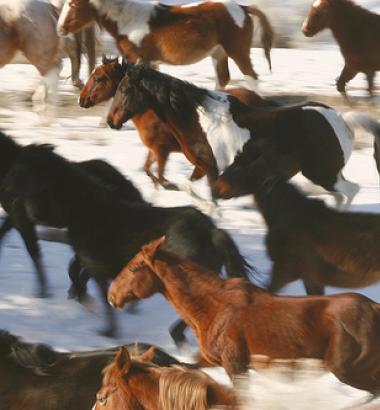
Horse Nation
The animals that some American Indian tribes referred to as Horse Nation would transform the history of West.
A few weeks ago, I stumbled upon the National Museum of the American Indian’s “A Song for the Horse Nation,” an exhibit celebrating the relationship between Native Americans and horses, animals introduced by the Spanish and whose value American Indians quickly appreciated. Having grown up with horses, and a competent, not to say elegant rider, I went in. Who doesn’t like to look at horses?
The horse was a major player in Indian history for only 100 years, but in that short time, many peoples, particularly those of the Great Plains, became legendary riders. “Horse Nation” attests to the intensity of that human-animal interdependence. The exhibit debuted in the museum’s New York wing, but the subject, too big for the 5,000-foot space, soon migrated to DC. Here, a full-size teepee and two life-size horse mannequins, among other things, spread out over nearly twice as much alloted space.
The curator, Emil Her Many Horses, works as a professional artist—he marries traditional Lakota beadwork with contemporary installations—and the exhibit is full of intricately-beaded horse head dresses and other decorations. Objects such as dance sticks, each carved to resemble a particularly treasured horse and carried into ceremonies, point to a spiritual link with horses. But the collection also contains traces of another story, an economic one. Horses were capital. Before horses arrived, women or dogs would carry teepees and other goods when breaking camp. No more. And with the advent of mounted bison hunting, teepees made of their hides got bigger. Tribes began raiding one another’s stock; (“we never say ‘steal,’ ” Her Many Horses said with a smile).
In his book, The Comanche Empire (2009), Pekka Hämäläinen, a professor of history at University of California, Santa Barbara, goes further in stressing the horse’s importance. The people who would come to call themselves Comanche were once a little-known tribe of hunter-gatherers who traveled out of New Mexico in the early 1700s to become colonizers (and slavers) of the southern Plains, vying with other indigenous groups as well as the Spanish, French, Mexicans, and Americans for territory and trade. There were several reasons for the Comanches’ rise, Hämäläinen writes, but at the center was the horse. Unlike dogs, which required meat, horses ate grass: “A conduit between immense, abstract solar energy and concrete, immediately available muscle power, the horse redefined the realm of the possible, bringing the Comanches a step closer to the sun.”
Astride their horses, the Comanches reshaped the settling of swaths of country:
Horses allowed the Comanches to dominate long-distance trade networks and extend their raiding sphere hundreds of miles south of the Río Grande, far beyond the grasslands, which were the natural core area of North America’s hunting-pastoral societies. With horses, Comanches could transfer information more effectively, spread out more widely, and come together more frequently. The equine revolution, in short, compressed time and distance, reducing the daunting expanses of the Great Plains, the Southwest, and northern Mexico to a size a single polity could manage and dominate.
Typical Comanche camps numbered about 250 people and 1,000 horses and mules. Having forsaken most gathering for mounted hunting, Comanches exchanged bison meat for corn and other carbohydrates. Surplus stock was kept for trade or to mark status.
If horses allowed the Comanches to push back against indigenous and European peoples coming from the east—and against the “skewed” notion of “eastern power and dynamism toward western weakness and passivity”—equines would also contribute to the decline of Comanche rule. The bison were overhunted, and even the huge, southern Great Plains couldn’t sustain the massive herds of horses now treading its earth. A 20-year drought starting in 1845 marked the beginning of the end.
Now, only a few tribes, among them the Crow, Lakota, Blackfoot, and Navajo, maintain equestrian cultures, Her Many Horses said. The great-great-grandson of a woman known for the number of horses she owned (thus his surname), he admitted that he didn’t ride until he went to college in his home state of South Dakota and took a horsemanship class. Assuming that an Indian could ride, the instructor put him on Powwow Warrior, an easily antagonized, bucking appaloosa with whom he developed a love-hate relationship that ended with the semester. Still, images of horses appear in his artwork. “If we talk about horses, we don’t depend on them like we once did,” he said. “But they’re a part of who we are.”
Photo by Jeremy Hiebert via Flickr.